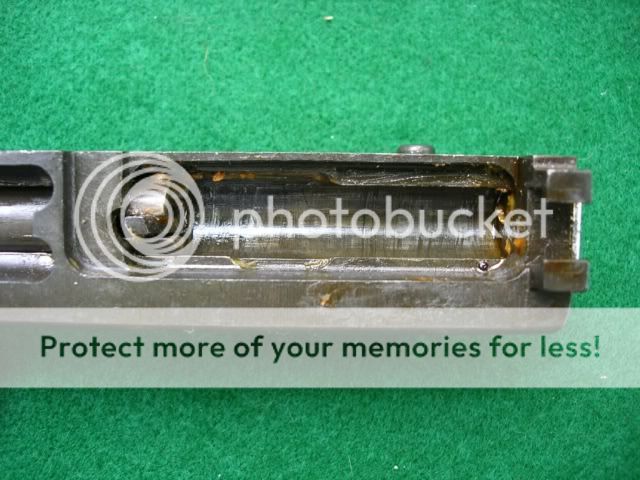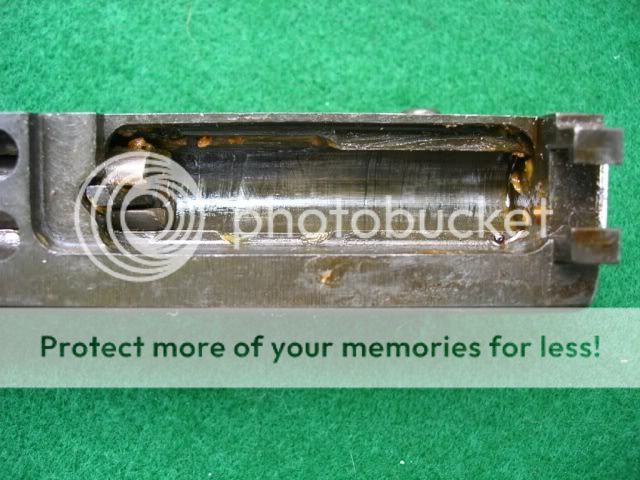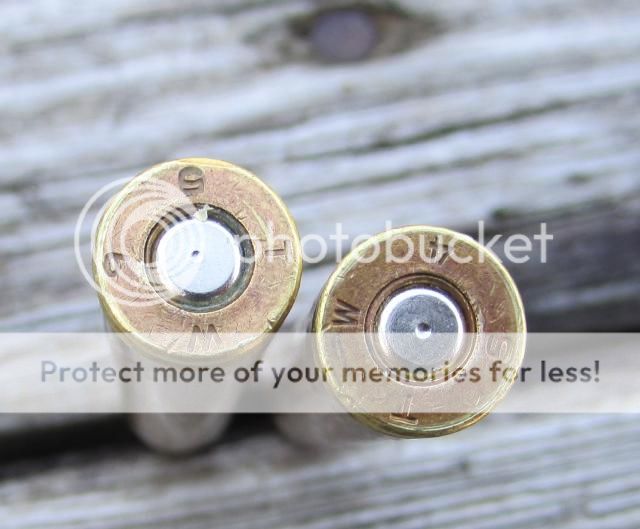These are pictures of out of battery slamfires that occurred in Garands. Out of battery pictures are extremely rare, and these rounds look different from the two out of battery slamfires, in Garands, that I had. In each incident, the case burst below the shoulder. I sent those cases to the gunsmiths who had barreled my match Garands and that was before cheap digital cameras.


My cases looked like short cylinders, the cases ruptured below the shoulders and what was left, looked like someone had wet jet cut the cases. Very clean and even cut. These cases look differently and it is apparent due to the case swelling, that they were not fully seated in the chamber when primer ignition occurred.
Slamfires are primarily due to overly sensitive primers. You will run into a group of people I call "Davidians", mostly on Culver's and
M14 forums, who believe that only high primers and a worn out "safety bridge" cause slamfires. They were taught this by the US Army, and civilian consultants who also wrote articles for the American Rifleman. The last big article on this, in the American Rifleman, was written by the Prime Davidian. Essentially he claimed the Garand mechanism was perfect, it positively blocked any incidental contact between firing pin and primer, and that the only causes of slamfires were worn out receiver bridges and high primers. The last two causes are shooter misconduct, you allowed your gun to be worn out and you did not seat your primers to depth. What I find interesting about the Prime Davidian is that he was the Government technical expert at the Ichord hearing, he worked on the M16 slamfire investigation, may have lead it. And he determined the primer sensitivity requirements for the M16, to prevent more slamfires. The early M16 used sensitive commercial primers and had a very heavy firing pin. The firing pin was lightened, and the military primer, the #41, was made less sensitive.

Yet, when the M1 Garand and M1a ruled the firing line in NRA sponsored high power matches, when writing an article about the slamfires and the Garand mechanism, in the NRA magazine, American Rifleman, the Prime Davidian never once mentions primer sensitivity. There is no such thing as primer sensitivity, a primer is a primer, is a primer. A reader is left with the assumption that primers are very consistent, only ignite when desired, and that they are all similar, if not identical. Davidians, as a general rule, don't believe that primers vary in sensitivity, and they absolutely don't believe that incidental contact between a firing pin and primer can cause the primer to ignite, either before trigger pull, or before the action is in battery. They have been taught, and they will always believe, that slamfires are only due to shooter negligence. Davidians tend to be judgmental types, positively Puritanical in their viewpoint: that is, evil happens to evil doers. This was an early doctrine of Calvinists in general, that is God protected the select from harm , but you could identify the damned by the misfortune in their lives. Who wants to show, or discuss his slamfire when you know this nasty, irrational type of person will be commenting in the thread?
In any mechanism with a free floating firing pin, there exists the potential of primer ignition due to incidental contact between the firing pin and the primer. It all depends on primer sensitivity, and primers that are more sensitive on average, are more likely to have a firing pin initiated slamfire. Pistol mechanisms do not have the ignition power of rifle mechanisms, so pistol primers tend to be more sensitive than rifle primers. If you notice, very few modern pistol mechanisms have free floating firing pins, starting I think, with the P38 (or maybe earlier, don't know) pistols began having firing pin blocks. These firing pin blocks not only prevent accidental discharge if the pistol is dropped, it prevents in battery slamfires as rounds are chambered.
I am unaware of any semi auto rifle actions that have firing pin blocks. Rifles control slamfires through other techniques, and through primer sensitivity. Military rifles have robust ignition systems, tend to have heavy firing pins, so you will find that military rifle primers are less sensitive than commercial primers sold to American reloaders. One design technique is used by the FAL to reduce slamfires is a spring loaded firing pin. The spring reduces the energy of the firing pin as it rebounds within the bolt. Also, the FAL action was designed so that the firing pin is out of alignment of the primer prior to bolt battery. The bolt face is off axis from the center line of the cartridge, before the rear of the bolt is in battery.

Here the bolt is lined up, as it would be in battery, and the free floating firing pin is perfectly able to rebound off the primer.

I have found a number of accounts of in battery slamfires in FALs, but not an out of battery slamfire incident. However, the previous design, the FN 49, has a number of out of battery accounts on the web:
http://forums.gunbroker.com/topic.asp?TOPIC_ID=367888
Out of Battery Slamfire in FN49
http://thefiringline.com/forums/showthread.php?t=543905
Kaboomed 8mm Egyptian FN-49 .... Now A Floorlamp!!!!
http://www.sksboards.com/smf/index.php?topic=132165.0
Argentine 49 7.62x51 KABOOM!
http://www.surplusrifleforum.com/viewtopic.php?f=43&t=106950
These slamfires occurred in spite of anti slamfire feature that the designer patented:
Tilt Locking Breechblock for Automatic Firearms D. J. Saive July 18, 1950, 2,515,315
The spring 32 also forms a safety device (Figure 14) for preventing firing when the breech block is unlocked. As shown in 'Figure' 14, the firing pin 31 has a groove 31a in it and the spring 32 has a lug 32a on it which acts as a safety and, by engaging in the groove 31a, holds the firing pin against forward movement when the breech block is unlocked . When the breech block is not locked (Figrue 8) the rear end of the slide projects beyond the rear end of the firing pin thus preventing the striker from striking said firing pin.
I don't have an FN 49 bolt to examine, but Mr.Saive must have changed the bolt design from the FN 49 and the FAL.
There are other causes of slamfires, mechanical ones. If the hammer follows the bolt down, pressing the firing pin foward, than a slamfire will happen. If had this happen in my first FAL, it was due to a worn out sear/trigger and the thing would double. Thankfully it slamfired in battery.
My Fal probably would not have slam fired if the BATF had not required the safety sear to be taken out of the mechanism. The safety sear is used in automatic fire, and most stupidly, the BATF required it to be taken out. But that safety sear slows hammer reset, and the hammer is less likely to over ride the trigger sear when the safety sear is installed.

One of the rarest types of slamfires is the one of the corner stones of Davidianism: the high primer. Yes a high primer can ignite but a couple of conditions have to be met. The first is that the primer anvil is firmly seated on something. If the anvil is dangling in the air, the most common effect of a high primer is then a misfire. You will read about these all the time and the best advice given to reloaders whose ammunition is misfiring on first strike, but going off on the second, is to seat the primers deeper. The first hammer strike typically seats the primer, the second sets it off.
However, if the cartridge has a shallow pocket, it is possible that a high primer could ignite just through contact with the bolt face. Or, if someone is sticking spacers under their primers, firmly seating the primer anvil on that spacer, but leaving a high primer, than that primer could go off through bolt face contact. This is how Wayne Faatz got his primers to ignite. You can read Wayne Faatz’s article “The Mysterious Slamfire”.
https://www.scribd.com/document/2649554/The-Mysterious-Slamfire The guy had a slamfire, assumed it was something he did, because the only causes were all “user” causes: there was no acknowledgement at the time that Garands/M14’s, M1 carbines are susceptible to slamfires and there was no acknowledgement that primer sensitivity varied between brands. His article was published in Davidianism central; The American Rifleman magazine. The American Rifleman actively promoted the idea that slamfires were all due to shooter negligence and this article is an example of their agnotology . If you notice, Wayne Faatz could not get his high primers to slamfire. Even with high pistol primers, none of his high primers would go bang, that is, until, he inserted flattened pistol anvils under the primers. Then he had the condition of a firmly seated primer anvil and was able to get the primer to ignite by dropping the bolt.
In battery slamfires occurr frequently in AR15's, even though the firing pin has been lightened, most civilian ammunition is loaded with sensitive commercial primers. And many reloaders use the most sensitive primers they can find in their AR15's, so called match or benchrest primers, which tend to have thinner cups than military primers. This is the first thread I have ever seen a a documented example of an out of battery slamfire, and I would like to ask the permission of Denton to use his picture, with reference to his post, of an example of an out of battery slamfire in an AR15 mechanism.
Stoner did a good job in designing in features in his AR15 mechanism which reduce the risk of an out of battery slamfire. The firing pin is positively retracted until cam down. The early M16 slamfire accounts we have are all in battery slamfires. I have one shooting bud, who works as a security guard for a Government facility. He and the other security guards were undergoing training, with Government M4 carbines, using Federal Gold Medal match 223. Bud told me that one of the military M4's slamfired out of battery. Bud has seen decades of slamfires with Garands, M1a's, so he ought to know what an out of battery slamfire looks like, but, proving something like that to a Davidian, based on hearsay, well, it is not going to happen.
I don't understand how a AR15 mechanism can slamfire out of battery unless the primer is so sensitive that it just goes off, due to inertia. Or if there was something on the bolt face.
From the pictures I see, that the OP posted, that looks more like an over pressure event than a slamfire. The case head has blown out. The case head has blown out through the thickest portion of the cartridge case. I have seen similar pictures and I think something was wrong with the ammunition, not the gun.






















